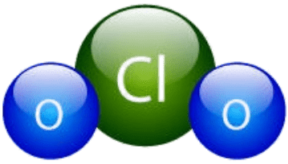The Miracle Molecule - Chlorine Dioxide
What Makes This Oxidizer Superior to All Others
The History of the Molecule
Chlorine Dioxide, a molecule consisting of just one chlorine and two oxygen atoms, was first discovered by Sir Humphrey Davies in 1811. For nearly 140 years, little was done to explore or employ this discovery into any form outside of the laboratory.
Then, in 1944, out of measure of some desperation, Niagra Fall, NY had an onsite chemical generator installed to address a serious problem with the odor and taste of their water after purification by means of their previous chlorine (only) treatment program. The results were amazing. Within 30 years, another 3000 facilities had converted to this superior biocidal system for water treatment. Soon after, the Pulp & Paper industry converted their processes to include Chlorine Dioxide and ClO2 became an alternative for large scale food processing sanitation.
Characteristics of the Molecule
Chlorine Dioxide is a gas, and remains such at all temperatures over 51oF. Even when added to water, it does not hydrolyze – but remains a gas, and it is 10 times more soluble in water than straight chlorine. This means that may be effectively delivered by water, but it far more stable and effective than other forms of disinfectant. We will speak more to this later.

What Makes Chlorine Dioxide "The Perfect Biocide"?
In the beginning, ClO2 could only be either generated onsite (with massive equipment and hazardous chemicals) or delivered in bulk totes – an expensive and dangerous proposition in 3000 and higher concentrations. Now, be it through onsite generation through liquids, powders or tablets, the majority of the safety concerns have been addressed. Furthermore, being the ONLY singular chemistry able to sanitize WATER, AIR and SURFACES, the World Health Organization (WHO) has deemed it the “Perfect Biocide”.
A Gas Trapped in Water?
As mentioned earlier post, ClO2 is a gas, and does not hydrolyze in water. This means that its characteristics do not change, its components do not break down and it does not become what we might call a traditional “solution”.
Chlorine Dioxide is simply a gas, delivered by the vehicle – water – and it just along for the ride.
Let’s continue with the analogy: put a seat in a car, and it becomes an integral and essential part of the car. Put a passenger on the seat, and he or she does not become an integral part – removing the passenger does not detract from the car, remove the seat and it is less than a car. You can tell it’s there from the distinctive yellow color.
Does Dissolving ClO2 in Water Change its Character?
This molecule, which can be added to water without being altered in state, function or power, is on a hunt. The ClO2 molecule, somehow, has an innate understanding of its place in Creation. It is designed and determined to find and attack pathogenic invaders. While it employs oxidation to disinfect, it is selective – looking specifically for (from smallest to largest) microbial contaminants. Being so small in size, it can simply leave its aqueous vehicle, pass through the lipid layer of a virus or the membrane of a bacteria and begin its work of dismantling the matrix of the microbe.
Does Chlorine Dioxide Exist Organically?
The generation of this molecule is closer to home than one might think. Being reacted into the molecular union of Chlorine and Oxygen, designed to work at extremely low concentrations and being selective in its attack strategy, what can possibly be better compound to place within our own white blood cells?
Three of the Earth’s most abundant resources are Air, Water and Salt. Without any one of these we cannot live, and furthermore, without the formation of the ClO2 (chlorine from the salt, and oxygen from air and/or water) we would have no means of fighting off infection or decay.
ClO2 - Better than Bleach or Ozone?
For decades, bleach has been the “go to product” for disinfection. When deep disinfection is required, or an outbreak has occurred, facility and housekeeping managers have mandated the use of bleach for hard, inanimate, non-porous surfaces. The problems associated with using bleach are manifold: Bleach must be used at much higher concentrations than ClO2. Bleach will react very differently depending on the pH of the surface or the solution to which it is added*, and ClO2 is not as susceptible to decay by interaction with organic materials. To summarize – you get 5-10 times more ‘bang for your buck‘ with chlorine dioxide.
*Bleach must be used in a very narrow pH range (5-7.5); ClO2 may be used in solutions ranging from 2-11 in pH.
Simply put, when compared to Ozone, with ClO2 you get far greater surface penetration, greater consistency and faster odor elimination from hard and soft surfaces in a vehicle.
ClO2 - Safer than Bleach or Ozone?
For decades it has been known that when elemental chlorine gas or liquid bleach is added to water, the acid it creates it is likely to come into contact with particular organic matter that precipitates the creation of trihalomethanes, a carcenogenic byproduct that can cause cancer in humans and animals. Furthermore, ClO2 is the ONLY selective oxidizer and does not naturally degrade ferrous metal derived materials like steel and chrome. That means your surfaces are safer with ClO2.

Ozone, is even more corrosive than Bleach, doing damage to not just metals, but also plastics and rubber substrates - ClO2 is the least corrosive of all the oxidizers. .
Disinfecting & Deodorizing Through Oxidation?
Atoms are composed of matter with electrically charged particles: Protons (+), Electrons (-) and Neutrons (0). The class of biocides referred to as “oxidizers” all work by means of an electron exchange – one atom gains and the other atom loses an electron. All oxidizers may be measured by means of their ‘oxidation strength’ and their ‘oxidation capacity’ or ‘potential’. The higher the ‘strength’ the more powerful the attack, the higher the ‘capacity’ the greater the longevity. It can be compared to two armies – one with a single large cannon (but just a few cannon balls), and another with several small artillery AND an abundance of ammunition.
The very fact that the chlorine dioxide molecule is so small is what makes it so quick and effective. When looking for matter to oxidize, the ClO2 molecule begins with the smallest opponents first – viruses, bacteria (of various sizes), spores, fungi and protozoan. It’s strength is exhausted only progressively, and not before it exacts destructive force on the toughest of microbes.
Applicable Videos
This set of old video was produced when I was beginning my initial study of Chlorine Dioxide and wished to create a living journal of what I was discovering.
This more recent video explored a potential means of dispensing low doses of ClO2 (from an aqueous solution) into occupied air spaces for the purpose of reducing microbial contamination and odors in residential or commercial spaces.
This video provides an overview of the ClO2 gas distribution machine we offer to those who prefer an alternative to buckets and pumps when deodorizing air spaces.
This old video was produced when I was consulting for another ClO2 manufacturer. I wanted to test a theory that electrostatic spraying equipment made little to no difference when applying Chlorine Dioxide.

